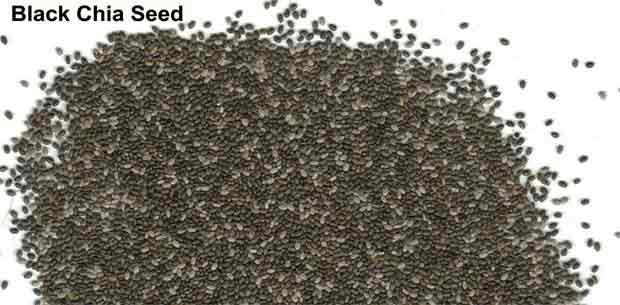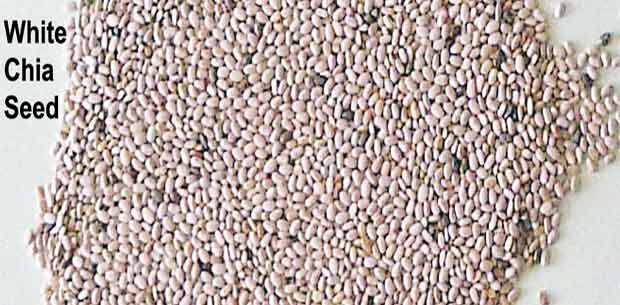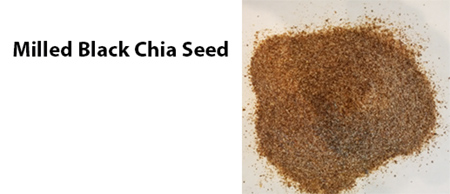Chia Seed Research
Dr. Wayne Coates has conducted a range of chia research over the past 20 years, and he has a great deal to share about these fascinating seeds. Chia seeds are an excellent source of omega-3 fatty acids, antioxidants and fiber (soluble and insoluble). The small seeds can be mixed in water or juice to make a refreshing beverage, sprinkled on cereal or salads, or can be ground and mixed with flour and baked. They have little flavor. Chia seed is similar to flaxseed, but does not possess any anti-nutritional compounds found in flax. View the video slideshow.
Chia Health Benefits
Chia – Types of Products for Sale
Chia for Animals
Chia vs. Flax
Chia vs. Other Foods
Chia Seed – Research Studies and Technical Information
Chia Health Benefits
Chia has often been described as the “World’s Healthiest Whole Food” and is cited as such in the January 2010 issue of “O” magazine, page 91. There are many things that can be said about chia and its health benefits. The way I often talk of chia in general terms is to say chia contains four main components: omega3 fatty acids, fiber (soluble and insoluble), antioxidants and protein.
Of these four components, three have been shown to have significant health benefits. Specifically, omega3 fatty acids and fiber have been shown to have positive health benefits in terms of heart health. Omega3 fatty acids and antioxidants have been shown to help reduce inflammation and increase immunity.
When you consume chia, your body will utilize those components of the seed that will most beneficially affect it, and hence will tend to improve your health. Some people have experienced reduced cholesterol levels, some have seen less joint pain, some have lost weight (due to the fiber acting to promote satiety), some have have had increased energy and stamina. As with any food, the effect it will have on your body will vary, and could be from being nothing to being very significant.
The following articles were written to provide more insight into chia and how it can affect your body’s health:
Learn about functional foods
Learn about conversion of ALA omega3 to EPA, DPA and DHA
Chia Types of Products for Sale
Is all chia seed created equal? Is one kind of chia seed better than another? Having started my research on chia seed at the University of Arizona in 1991, I believe that I understand the crop, its health benefits, etc. as well as anyone. First of all you need to be aware of the various forms chia and its components are sold. There are four possibilities:
- Whole chia seed
- Milled (ground) chia seed
- Ground chia flour (what is left after most of the oil has been extracted, and then has been ground)
- Chia oil
How do they compare?
Whole chia seed is the way Mother Nature produces this crop. In theory, milled (ground) chia seed should allow chia seeds’ nutritional benefits to be readily available for the body to use, but there is no scientific proof that this is the case with chia. Ground chia flour contains significantly less Omega-3, but has more fiber and protein and all of the antioxidants in the whole seed.
Chia seed’s composition varies depending on where it is grown and when it is grown. Cooler climates (or higher elevations) increase the oil content, which in turn increases the omega-3 content. To see some examples of the variation look at Chia Seeds By Location (table). This table was created using analyses of chia seed sent to independent laboratories to determine seed composition.
Now what about the chia you can buy on the internet and in stores?
Consider the following when purchasing Chia seeds:
- There is a dramatic range in chia seed prices. When comparing prices, also look at the weight, since package sizes vary dramatically.
- Stated chia seed composition varies. Complicating the comparison process is the fact that serving size varies. To compare products you need to use a standard size, say 100 grams, convert the sellers stated compositional amounts per serving to a 100 gram size, then calculate how much does the omega3, for example, cost per 100 grams.
- Be aware that the chia seed’s label values and website values are what the seller claims the composition to be. All label values have been rounded, and FDA regulations allow a margin for error in them. Depending upon the test method used to determine the values, and the quality of the facility that determined them, variations are very likely.
- Another consideration is cleanliness and maturity of the chia seed. I have seen chia seeds being sold that are not only dirty, but contain weed seeds and plant parts. I also have seen chia seed sold that hasn’t had the opportunity to mature. Both of these problems will dramatically reduce the nutritional value of the chia seeds. Look at these photos to compare good and bad quality chia seed. Any seed you see that is not either black or white is not good quality chia or is a weed seed.
Hence all stated chia seed values should be considered as a guide, especially since some websites provide absolutely no analysis information about their chia. Once you have located quality chia seeds, you can begin using them in various chia seed recipes. Over 100 free chia seed recipes can be found on our website.
My best advice: do not judge chia seed by price alone. Reputation is a key consideration.
Chia Seed Nutrition and Composition Research
Chia Vs. Flax
Is chia seed better than flax seed?
As with anything, there are pros and cons. If there is one thing that stands out when comparing chia seed to flax seed, it is ease of use. The way I like to explain the difference is as follows: “Mother Nature prevents the omega3 in flaxseed from going rancid by a hard seed coat. In the case of chia the omega3 content is protected by the natural antioxidants in the seed.” What this means for you is that if you want to get the benefits of the omega3 from flaxseed, you need to grind, cook, sprout or somehow open the seed so that the digestive process can be effective. If you do not do this, the seeds will just pass through your body. This is not the case with chia, you can eat whole seed, and you will get essentially all of the benefits of the omega3 as well as the other components in this very special food.
The second advantage which has over flax seed is that if you do like to eat milled (ground) chia you can prepare it, leave it on your countertop, and it will not go rancid. This is very different from flax seed which should be ground fresh every day. Why is this the case, again it is the natural antioxidants in chia seed which prevent rancidity.
One other comparison that needs to be addressed is that flax seed contains some “antinutritional” compounds, and hence there have been warnings and restrictions placed on it use as a food. To learn more about this click here.
Another interesting way to compare these two seeds is to look at the composition of each. The table shown here gives a generic comparison of chia seed and flax seed. These are generic numbers and do not mean this is what you will necessarily get when you buy chia or flax in the stores or on the internet. Where the seed is grown, how it is grown, and in the case of flax seed the variety that is grown, will all affect their composition.
Chia for Animals
Is Chia Good For Your Dog or Cat?
Fats are an important component of dog and cat diets. They provide a good source of energy, and supply essential fatty acids needed for proper growth and maintenance. Dietary fats also improve food palatability and texture.
There are similarities in lipid (fat) metabolism among dogs, cats and humans, however differences do exist. Unlike humans, dogs and cats can tolerate high dietary fat concentrations, with cats being very unique regarding their fatty acid metabolism. Unlike humans, a decrease in linoleic acid (LA) in dogs and cats is not recommended, in fact higher amounts of LA are considered not only safe, but efficacious.
Digestibilities of crude fat are generally high. For dogs it varies from 85 to 95 percent, for cats as high as 99 percent has been recorded. In fact, higher fat diets appear to more palatable for cats, than low-fat diets. Fats in general, and in particular LA or alpha-linolenic acid (ALA), have been shown to improve the skin and hair coat of dogs.
The recommended fat intake of fat for dogs is 5% of dry matter (DM), however to support growth and reproduction 8% is recommended. In general 1% linoleic acid intake is recommended. For cats a fat intake of 9% of DM is recommended for all life stages.
In terms of essential fatty acids (EFAs), the requirement for omega-6 in the form of LA is key for both dogs and cats. Under some conditions minimal amounts of arachidonic acid (AA) must be provided, however in general, dogs and cats can synthesize sufficient amounts of AA from LA. This is true for dogs at all times, however for cats during pregnancy and neonatal growth and development, AA needs to be provided.
Conversion of ALA to EPA occurs in dogs and cats, but conversion to DHA is limited. For adults the conversion may be sufficient, since the amount needed is small. However during growth, reproduction and lactation supplementation appears necessary.
Requirements for Dogs
Growth – adequate intake for LA is 1.18 % of DM and for ALA is 0.07 % DM, however it has been suggested that with a 10% safety margin these values be raised to 1.3 and 0.08, respectively. If however no long chain fatty acids (LCFAs) are included in the diet, the requirements may be greater.
Adult Maintenance – recommended total dietary fat for adult dogs is 5.5 % DM for a 4000 kcal/kg DM diet. LA should be included at 1.1 % DM, with ALA included at 0.044 % DM. No specific recommendation for long-chain omega-3 poly unsaturated fatty acids (PUFAs) has been identified.
Gestation and Lactation – total dietary fat needed to support these stages of animal life are greater than for maintenance. The LA requirement is 1.3 % DM, and ALA is 0.08 % DM.
Requirements for Cats
Growth – total fat intake is 9% DM for growth, with LA requirement being 1.3% DM and ALA estimated to be 0.02 – 0.03% of DM.
Adult Maintenance – the requirement for LA is lower than dogs because unlike dogs, very little LA is used for long chain PUFA synthesis in cats. A safe upper limit for LA is 13.8 g per 1000 calorie of diet. No metabolic requirement for ALA has been identified in felines, nor has one for long-chain omega-3 PUFAs.
Gestation and Lactation – total fat intakes are the same as for maintenance, however absolute intakes will be greater because of increased energy needs overall. The LA requirement is 0.55% of DM for a 4000 cal/kg diet, with AA set at 0.02% DM. For ALA 0.02% DM has been estimated because of limited omega-3 long chain PUFA synthesis.
How much chia should I feed to meet ALA requirements?
Chia contains on average 18 g of ALA per 100 g of seed, or 0.18 g ALA per g of seed. Thus, as an example, the calculation for dog growth is:
0.07% per 100g DM = 0.0007g/100g DM, thus 0.0007/0.18 = 0.39 g/100g of DM
Chia Amounts for Dogs
Growth – 0.39 g/100 g DM or 1.77 g/lb DM
Adult Maintenance – 0.24 g/100g DM or 1.09 g/lb DM
Gestation and Lactation – 0.45 g/100g DM or 2.04 g/lb DM
Chia Amounts for Cats
Growth – 0.17 g/ 100g DM or 0.78 g/lb DM
Adult Maintenance – does not appear to be required
Gestation and Lactation – 0.11 g/100 g DM or 0.50 g/lb DM
Is Chia Good For Your Horse?
Although there has been no detailed studies to date we are aware of, a number of breeders, trainers, riders, owners, etc. have fed chia to their horses and seen some very interesting results. One of the most striking observations that has been made on more than one occasion is an enhanced appearance and shininess of the coat, mane and tail. Hoof growth has also increased dramatically. In other cases temperament has improved, with the animals being somewhat calmer. This does not mean lethargic, rather less excitable.
Several trials were conducted by an equine specialist which show some promising results and should be of interest to all horse owners, helping with pregnancy, a mare’s udder tumor, allergies, and insulin resistance.
To read about how chia has helped maintain pregnancy please read this account.
In another trial chia helped with a mares udder tumor.
Chia has also helped with allergies
Additionally chia helped with insulin resistance
All of these studies are anecdotal, but they do show the potential that chia appears to have if fed to horses.
The June 2010 issue of Equine International, pages 16-17, features an article on feeding chia to horses in the summer to help with allergic reactions to fly bites. You can read it here
How much chia should I feed to meet ALA requirements?
Chia contains on average 18 g of ALA per 100 g of seed, or 0.18 g ALA per g of seed. The problem is NO ALA requirement has been established for horses so a specific recommendation cannot be made.
As chia has been classified as a food by the FDA for humans, and is listed as a feed ingredient in the Official Publication of the Association of American Feed Control Officials Incorporated official publication, there should be no concerns about feeding any reasonable amount.
Is Chia Good For Your Cattle?
Although there has been no detailed studies to date we are aware of, we have fed chia to our two Charolais heifers since purchasing them in November 2009 when they weighed about 500 lbs each and were approximately 6 months of age. The most striking observation is increased hair coat. Photos of the coat which were taken in August in Arizona, not the coolest of climate at that time of year, can be seen here. Their temperament has been remarkably calm as well, and could be due to the omega3 in the chia.
The two heifers were bred to an Angus bull in late December 2010, and calved in October 2011 within 30 hours of each other. Photos of the offspring can be seen here.
There were no problems with the delivery of either calf, or in the calves themselves have been noted, with both having somewhat heavier and more of a curly coat that would be considered normal.
How much chia should I feed to meet ALA requirements?
Chia contains on average 18 g of ALA per 100 g of seed, or 0.18 g ALA per g of seed. The problem is NO ALA requirement has been established for cattle so a specific recommendation cannot be made.
As chia has been classified as a food by the FDA for humans, and is listed as a feed ingredient in the Official Publication of the Association of American Feed Control Officials Incorporated official publication, there should be no concerns about feeding any reasonable amount.







